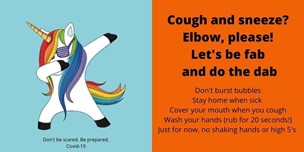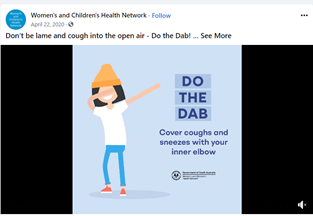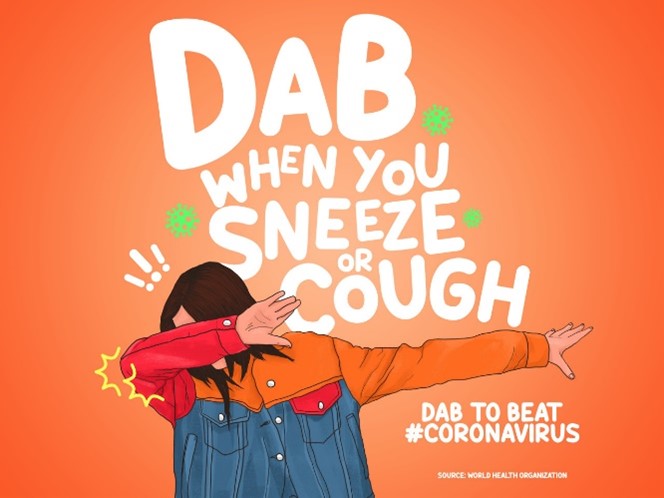Is there a role for fun in policy and social marketing?
Last week in the office, one of my colleagues was talking about the article I wrote on probabilistic reasoning and it resonated with her about how it might be linked to (what we suspect to be a decrease in) COVID Safe check-ins as she was questioning her own behaviours. Are people still checking in? Judging by the amount of people that walk past me when I stop to check in*, likely this has reduced since the introduction of the policy and social norms are changing. *Disclaimer: there have been times where I’ve subtly slipped past the QR code) :-/
It also reminded me of a couple of years ago when we were testing concepts for a flu vaccine campaign, we were talking about sneezing into our elbows which quickly turned into the office ‘sneeze dab’ joke. Little did we know the sneeze dab had taken off around the world well before, used in health campaigns and is still being used in COVID-19 messaging including the World Health Organisation and South Australia’s Women’s and Children’s Health Network.



It got me wondering how might fun or humour be used in something like COVID Safe check-in campaigns when it is likely becoming a chore for many, with a decreasing connection to the importance of why the program was introduced. How does the message that an action taken by you as an individual is for the safety of you as an individual but for the goal of social good? A population goal for social cause.
In any social marketing campaign, how do we ensure communications messages remain current, relevant and engaging to strengthen the success of the campaign in changing or maintaining a behaviour – ie, COVID SAfe check ins for the benefit of the community?
Social Marketing – has the primary goal of achieving “social good“. Traditional commercial marketing aims are primarily financial, though they can have positive social effects as well. In the context of public health, social marketing would promote general health, raise awareness and induce changes in behaviour.
Adding an element of fun to engage with a particular audience might just be the ingredient to success and ultimately, behaviour change.
When is it appropriate to use fun in messaging? Can fun be used in what makes sense to be serious messaging for social policy and marketing?
Cass Sunstein discusses “How fun might move the world” in a highly insightful and succinct podcast by The Decision Lab .
Cass describes fun as– something that makes you smile with a kind of ease and joy. Something associated with play, delight, a sense that life is good, sense of amusement.
Even in a pandemic, life will have moments of fun and how it can be considered in social marketing and messaging to promote better outcomes. Fun as a solution in a policy space can help engage with the public. Or even politicians engaging with the public. A sense of fun has a sense of equality – connecting with ordinary people and their ordinary concerns.
He mentions some examples:
A Prime Minister that ‘levels’ to connect
Jacinda Adern, New Zealand Prime Minister, during the early stages of the pandemic and potential lock downs made a joke. While the situation was serious, the tooth fairy and easter bunny would get travel exemptions.
Cass says “To say that in the midst of something not good is to make ones fellow citizens smile and laugh a bit and to do that is an instrument of making the days better and an instrument of making the suggested or mandated behaviour change not merely more tolerable but also kind of a shared enterprise that makes people smile.”
PEPSI Max
In a commercial marketing context, he uses the example of Pepsi Max v Diet Pepsi (where the name ‘diet was dropped in 2009).
- ‘Max’ (ie, Maximum) is a fun concept – with the emphasis on the fun aspect in the name
- Diet by contrast is, well, a diet. Diets are not fun!

The dining hall experiment
A study out of Stanford University in the US discussed the use of evocative words to change behaviours and increase vegetable consumption. After a 6 week study in a student cafeteria “The dining hall experiment” found that luxurious sounding names for every day vegetables prompted in increase in uptake.
- Use of the word ‘healthy’ increased consumption by 14%. Yes healthy is good (but sounds a little boring)
- Tasty and delicious, however sound more fun and increased consumption by 25% in contrast.

Extract from the study:
“Eating well isn’t always easy, and the reality is simply telling people which foods to avoid doesn’t do much to get them to eat better. What does work, Stanford psychologists now argue, is highlighting how tasty nutritious food can be. Evocative labels such as “twisted citrus glazed carrots” and “ultimate chargrilled asparagus” can get people to choose and consume more vegetables than they otherwise would – as long as the food is prepared flavourfully.
“This is radically different from our current cultural approach to healthy eating which, by focusing on health to the neglect of taste, inadvertently instills the mindset that healthy eating is tasteless and depriving,” said Alia Crum, an assistant professor of psychology and the senior author on the new paper. “And yet in retrospect it’s like, of course, why haven’t we been focusing on making healthy foods more delicious and indulgent all along?”
The outcome: Health marketing as a part of social marketing, must influence individuals, voluntarily, through various social programmes, in order to accept, reject, modify or abandon a behaviour in favour of a healthier lifestyle.
Nailed it!
Amazon Frustration Free Packaging
Frustration free packaging from Amazon was introduced way back in 2008 to:
- Be less time consuming and frustrating to open
- Protect the product during the shipping process
- Reducing solid waste and being environmentally preferrable (100% recyclable)
Certified FFP (Frustration Free Packaging) is recyclable and comes without excess packaging materials. The product inside is the same and everything is included in the Certified Frustration-Free Packaging that would be in the original manufacturer’s packaging. [AMAZON]
Making an acknowledgement of the worth and time of its customers.
While commercial marketing is aimed at the sale of goods and services (for profit), social marketing seeks to sell a change in behaviour for the benefit of the individual and society.
When we conduct exploratory research into campaigns to help refine the messaging and connection with the audience, it is key to look at look at the user experience as well as the messaging.
It’s not always appropriate to include fun. Maybe a smile and a sense of meaning but not so much fun. The domain or space in which the message will be used must be considered first. Graphic or serious campaign messages for anti-smoking, electrical safety or road safety should likely stay serious. These are no laughing matters.
In my last article, I mentioned key to campaign evaluation is testing language and tone for clarity and understanding, relevance and connection. This is a fundamental part of many projects I have worked on when evaluating communications with the recipient audiences. Even translating medical terminology into lay terms as part of a current project I am working on, was eye opening for the project team. Changing ‘reducing the sensitivity of a scan’ to ‘reducing visibility of the cancer’.
References …




